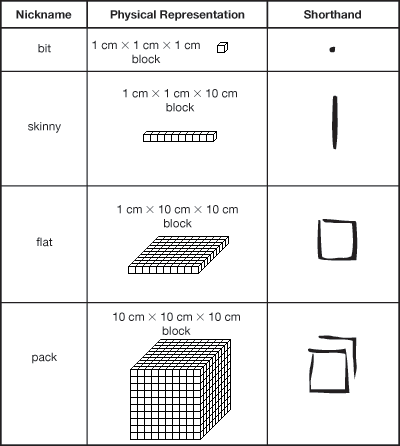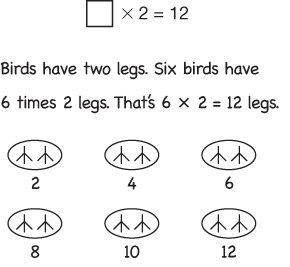Place Value Concepts
This unit extends students' work with place value to four-digit numbers to build an understanding of the base-ten place value system. Activities lay conceptual groundwork for performing addition and subtraction. Three- and four-digit addition and subtraction methods are developed in Unit 6.
Partitions to Place Value
In Lesson 1, students snap cubes together to make groups of ten. The act of… read more
Partitions to Place Value
In Lesson 1, students snap cubes together to make groups of ten. The act of snapping them together helps students become familiar with the idea of trading with the base-ten pieces. Students use cubes to partition numbers, leading to the notion of special partitions—groups of ones, tens, hundreds, and thousands. They represent their partitions using number sentences (e.g., 34 = 30 + 4 = 20 + 14). Partitioning is revisited throughout the unit to further develop number sense.
Base-ten pieces are used extensively to provide a concrete representation of the relationship between a digit's position and its value. This helps students understand how different digits in a number are used to represent different quantities.
Base-ten pieces are introduced in the context of the TIMS Candy Company that makes Chocos. Each piece is given a nickname so that students and teachers can refer to the concrete materials separately from the numbers. See Figure 1. This eliminates confusion when distinguishing base-ten pieces from the written number they represent, e.g., three “skinnies” from three in the tens place. Using nicknames provides flexibility to change the values of pieces when decimals are introduced. When decimals are explored, the flat is used as one whole, the skinny as one-tenth, and the bit as one-hundredth.
A shorthand for drawing the blocks is shown in the table. The shorthand allows both teachers and students to sketch the pieces quickly.
The physical appearance of base-ten pieces is particularly well-suited for developing an understanding of the base-ten system. (National Research Council, 2001). The ratios of the blocks' sizes are the same as the ratio of their corresponding values in the base-ten system. Working with base-ten pieces helps students visualize our number system's ten-for-one equivalencies. Each piece, once assigned a value, retains this value, regardless of where it is placed. The value of the piece is immediately known from its appearance.
The Base-Ten Recording Sheet 1 is used to record partitions of numbers and corresponding number sentences. By recording, for example, 2 in the skinnies column, students begin to understand that this 2 is different from recording 2 in the bits column. This 2 indicates two 10s, or 20. This develops the notion of the values of the places. When students have formed the connection between the blocks and numbers, they can easily form mental pictures of the blocks when solving problems. By recalling the blocks, students can make sense of regrouping when adding and subtracting. Then, they can figure out for themselves the steps involved. Subsequently, they make fewer mistakes and regard mathematics as a subject that should and does make sense. Research shows that students who learn to add and subtract using base-ten pieces have a much greater understanding of place value than those who do not (Fuson and Briars, 1990).
Comparing Numbers
The relationship of the block sizes also makes base-ten pieces an ideal tool for… read more
Comparing Numbers
The relationship of the block sizes also makes base-ten pieces an ideal tool for comparing numbers and developing number sense for larger numbers. Children can see that one or two of the large blocks will have many more units than the same number of smaller blocks. They compare, order, say, and write large numbers to gain confidence and fluency in working with numbers.

Figure 1: Base-ten pieces
Number Lines
To be able to develop flexible and efficient methods for addition and subtraction… read more
Number Lines
To be able to develop flexible and efficient methods for addition and subtraction, students must be able to compose and decompose numbers mentally. To develop visual images that will support this thinking and development of place value concepts, students represent numbers as moves of ones, tens, and hundreds on number lines as shown in Figure 2.

Figure 2: Representing 124 on a number line
MATH FACTS and MENTAL MATH

Subtraction Facts
Students review the following subtraction facts to maintain and increase proficiency… read more
Subtraction Facts
Students review the following subtraction facts to maintain and increase proficiency and to learn to apply subtraction strategies to larger numbers. See Mathematics in this Unit in Unit 2 for more about subtraction facts development.
Group 5: 7 − 3, 7 − 5, 7 − 2, 11 − 2, 8 − 6, 5 − 3, 8 − 2, 4 − 2, 5 − 2
Group 6: 6 − 4, 6 − 2, 13 − 5, 8 − 5, 8 − 3, 13 − 8, 12 − 8, 12 − 4, 12 − 3
Multiplication Facts
Students review the following subtraction facts to maintain and increase fluency and to… read more
Multiplication Facts
Students work on developing number sense for the multiplication facts for the 2s and 3s in this unit by writing a story, drawing a picture, and writing number sentences for math facts. See Figure 3. For more about the multiplication facts development see Mathematics in this Unit in Unit 3.

Figure 3: Example story and picture for  × 2 = 12
× 2 = 12
ALGEBRA in the EARLY GRADES

Open number sentences make it much easier for students to think about the effects of… read more
Open number sentences make it much easier for students to think about the effects of changing a numerical value in the situation and therefore support the shift in focus from particular to general relationships. Also, if students regularly use expressions to represent values, it is a much smaller step to using formulas to represent values (Smith and Thompson, 2008).
Resources
- Fuson, Karen C., and Diane J. Briars. “Using a Base-Ten Blocks Learning/Teaching Approach for First- and Second-Grade Place-Value and Multidigit Addition and Subtraction.” Journal for Research in Mathematics Education, 21 (3), pp. 180–206, 1990.
- National Research Council. “Developing Proficiency with Whole Numbers.” In Adding It Up: Helping Children Learn Mathematics. J. Kilpatrick, J. Swafford, and B. Findell, eds., pp. 181–229, National Academy Press, Washington, DC, 2001.
- Smith, John P., and Patrick W. Thompson. “Quantitative Reasoning and the Development of Algebraic Reasoning.” In Algebra in the Early Grades. J. Kaput, D. Carraher, M. Blanton, eds., pp. 95–132, Lawrence Erlbaum Associates, New York, 2008.
- Van de Walle, John A., Karen S. Karp, and Jennifer M. Bay-Williams. Elementary and Middle School Mathematics: Teaching Developmentally, 7th. Ed. Pearson Education: Allyn & Bacon, Boston, 2009.











